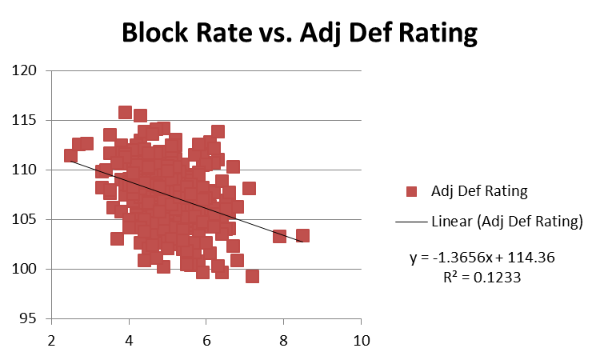The Correlation Between Team Stats and Offensive and Defensive Efficiency, Part 2: Blocks

In this series, we're looking at a variety of pace-adjusted team statistics and how they relate to offensive and defensive efficiency. For example, do teams that steal the ball a lot typically have good or bad offenses and defenses? This series is an attempt to look at trends in that regard.
Part 1 took a look at steals, and while nothing was truly conclusive, the data did seem to suggest that steals had a significant positive correlation to defensive efficiency. The offensive data showed a positive correlation in the last two years, but mostly normalized once stretched out to 10 years.
Today we look at blocks. Rim protection is probably considered the most vital part of a good defense in the modern NBA, so it will be interesting to see how the data reflects that thought. Also, does it affect offense at all? Let’s take a look.
How Blocks Affect Team Offense
The data shows that there is a slight correlation between good blocking teams and teams with highly-efficient offenses. Again, if you need help with that equation on the right, the number beside “x†is how much offensive efficiency (ORtg, or points scored per 100 possessions) is affected by blocks. The equation here says that for each block, a team has increased in offensive efficiency by about 0.34.

However, our coefficient of determination (R²) is quite low, which shows that there probably is no correlation between blocks and offensive efficiency.
To be anecdotal for a moment, this seems a little surprising. Like steals, blocks typically change possessions quickly. When Dwight Howard swats a ball to one of his guards, that player has a clear transition opportunity, and can usually get at least a one-on-one or two-on-two break, if not something more advantageous.
So, for the data to show no correlation, this might be because very few big men are actually skilled at blocking shots to their teammates. DeAndre Jordan coming from help-side to throw a ball into the stands looks great on SportsCenter, but it doesn’t change possessions, and thus, doesn’t help with offensive efficiency. Blocking it to a teammate seems difficult, and this might be why blocks don’t really affect offense when looking at a large sample size.
How Blocks Affect Team Defense
There's probably no surprise that blocks positively affect team defenses. There's a clear linear trend in the graph, and the R² value is high enough that we can be alright with assuming correlation. The data says that, for every block, the team saves about 1.37 points per 100 possessions.

However, this might be underselling the effect of blocks on a team defense. Since we’re looking at such a large sample size – really, it includes every defensive possession of the last 10 years – it doesn’t account for type of defensive possession. For example, a team’s point guard throwing a bad pass that leads to a wide-open dunk is still a defensive possession, but it’s not in the half-court setting and doesn’t really tell us much about blocks, since there was no opportunity for one.
Even still, for there to be a discernible trend even in the midst of the noise, further solidifies the importance of blocks and rim protection to good defenses. Speaking of noise, a statistic like blocks doesn’t measure rim protection perfectly. Roy Hibbert alters shots and deters penetration without racking up blocks like, say, Serge Ibaka does. Both are effective, but the former’s doesn’t necessarily always show up in the box scores.
Bringing It Together
Nothing groundbreaking – rim protection is key to a good defense, but we already knew this. I thought perhaps that we’d get some light on whether blocks affect offensive efficiency, but that turned out fairly inconclusive. Perhaps if centers were better at directing their blocks to teammates, they would have more of an effect on that end.
Let me know in the comments or on Twitter what you all think! Up next, rebounds!
















